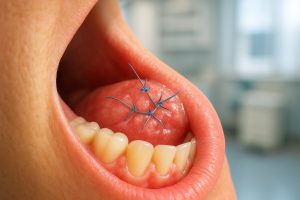When it comes to replacing missing teeth, dental implants provide a durable and natural-looking solution. A dental crown, when anchored by an implant, creates an artificial tooth that looks, feels, and functions like a real one. This setup is known as an implant-supported crown. But how do these components connect?
There are two primary ways to attach a dental crown to an implant: screw-retained and cement-retained methods. Each method has its own advantages and considerations, and the best choice depends on several factors, including aesthetics, durability, and ease of maintenance.
Understanding the Components of an Implant-Supported Crown
An implant-supported crown consists of three main parts:
- Dental Implant: A titanium post embedded into the jawbone, serving as an artificial tooth root.
- Abutment: A connector piece that links the dental implant to the crown.
- Dental Crown: The visible portion that mimics a natural tooth and sits above the gumline.
The crown attaches to the abutment either with screws or dental cement. Below, we explore each method in detail.
Cement-Retained Dental Crowns
One method of securing a dental crown to an implant is by using dental cement. This method is often preferred for front teeth, where aesthetics play a critical role. Since the cement is tooth-colored, it provides a seamless appearance, avoiding the visible screw holes associated with screw-retained crowns.
Advantages of Cement-Retained Crowns:
- Aesthetic appeal: The cemented crown blends naturally with adjacent teeth.
- Strong retention: Provides a secure fit that mimics a natural tooth.
- Smooth, natural surface: No screw holes, making the crown look more natural.
Drawbacks of Cement-Retained Crowns:
- Difficult to remove: If repairs or replacements are needed, the crown often has to be broken and replaced entirely.
- Potential cement residue: Excess cement can irritate gum tissue and lead to inflammation or infection if not thoroughly cleaned.
- Limited accessibility: If issues arise, such as implant complications, accessing the implant is more difficult.
Screw-Retained Dental Crowns
Screw-retained crowns use a small screw to attach the crown to the abutment. This method is especially common for back teeth, where aesthetics are less of a concern.
Advantages of Screw-Retained Crowns:
- Easy removal: If repairs, adjustments, or implant maintenance are needed, the crown can be easily unscrewed.
- More predictable placement: The ability to remove and reposition the crown ensures an optimal fit and alignment.
- No cement-related complications: Eliminates the risk of cement-induced irritation or infections around the implant.
Drawbacks of Screw-Retained Crowns:
- Visible screw access hole: In some cases, the access hole may be noticeable, though it can be covered with composite material to improve aesthetics.
- Weaker retention: Screws may loosen over time and require periodic tightening.
When to Choose Cemented vs. Screw-Retained Crowns
Cemented Crowns Are Ideal For:
- Front teeth where appearance is the top priority
- Patients who prefer a restoration that looks indistinguishable from natural teeth
- Cases where the implant’s angulation makes screw-retained crowns impractical
Screw-Retained Crowns Are Ideal For:
- Back teeth where function and durability are more critical than aesthetics
- Patients who may require future adjustments or replacements
- Situations where gum health is a concern, as screw-retained crowns reduce the risk of cement-related irritation
Temporary vs. Permanent Dental Crowns
Before placing a permanent crown, a temporary crown is often used to allow the gum tissue to heal and shape properly. Temporary crowns are usually screw-retained because they are easier to remove when it’s time for the final restoration.
Making the Right Choice: Consult Your Dentist
Deciding between a cemented or screw-retained dental crown depends on individual needs and preferences. Your dentist will assess factors such as tooth location, aesthetic concerns, and long-term maintenance when recommending the best attachment method.
If you’re considering dental implants in San Antonio, our expert team at Preferred Dental Center is here to guide you through the process. We offer personalized consultations to help determine the best dental restoration for your needs.
Schedule Your Consultation Today!
Request an appointment here: Preferred Dental Center to schedule a visit with Dr. Andres Biaggi at our San Antonio office.
Check out our patient reviews on our Google My Business Page to see why we are a top-rated dental implant provider in the area!
Understanding the differences between cement-retained and screw-retained crowns can help you make an informed decision about your dental implant restoration. Both options have their advantages, and the right choice depends on your specific needs. If you’re ready to restore your smile with a natural-looking, long-lasting dental implant, contact Preferred Dental Center today!



